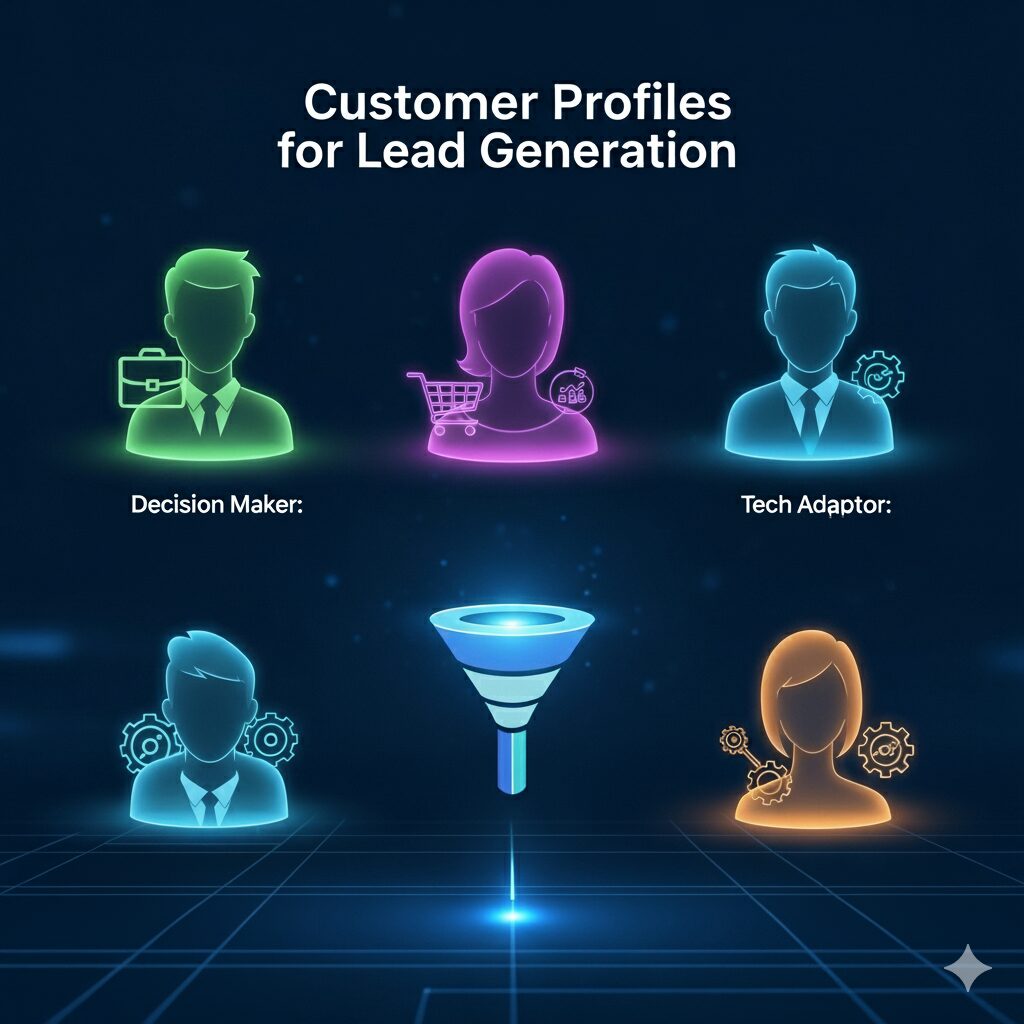The best way to generate leads in 2025 is to create highly precise and targeted customer profiles. This isn’t just a theory: a WP Swings study found that campaigns with targeted ICPs drive 80% more conversions compared to ones without defined customer profiles.
In short, the question isn’t, “Should I really invest precious time and money into creating a customer profile?” Rather, it’s “How can I spend the least amount of time creating the most precise and actionable ideal customer profile?”. That’s exactly what this guide will cover: it includes a step-by-step process for creating customer profiles, tools that can help you do it, and the benefits you can expect from targeted ICPs.
Let’s get started!
Table of Contents
- What is a Customer Profile?
- Benefits of Creating a Targeted Ideal Customer Profile for Lead Generation
- How to Create a Customer Profile: Step-by-Step Process
- Best Tools for Creating Customer Profiles
- Create Laser-Focused Customer Profiles with Lean Summits Solutions
- FAQs
What is a Customer Profile?
A customer profile is a description of a person who’s most likely to buy your product or service. Your customer profile will thus tell you about the demographic, firmographic, and behavioral characteristics of a potential customer – someone who will love your offering and be very easy to convert. Your ICP will also tell you where you can find them and how you can reach them.

Benefits of Creating a Targeted Ideal Customer Profile for Lead Generation
There are five main benefits you can expect from creating a targeted ideal customer profile:
- The ICP will define your target audience for product development and marketing.
- You will be able to offer more personalized experiences tailored through your ICP.
- Lower churn rate as your offering will closely fit the customer’s requirements.
- It’ll help you expand your customer base in the future with “close-fit ICPs”.
- You’ll save time, money, and effort required for lead generation.
How to Create a Customer Profile: Step-by-Step Process
Step 1: Analyse Your Existing Customer Profile
If you already have a growing or thriving business, your first step should be to analyse your existing customer database. You can do this by using a CRM platform that segments and summarizes your ICP. Alternatively, you can also see a breakdown of your revenue to identify your best-paying customers. This will give you a good idea of the kind of prospective clients you should go after in the future.
Step 2: Make a List of Pain Points Your Product/Service Solves
Next, create a detailed list of the problems that your product/service can solve. This will further help you define who is likely to benefit from your offering. It could be:
- Retail customers who want their goods delivered at home.
- Patients are struggling to find proper doctors or insurance plans.
- Businesses are looking for a long-term shipping partner.

Step 3: Start Asking Who Will Benefit the Most from Your Offering
This is the main part of the process: making the actual customer profile based on the information you’ve gathered. Here are the main points that you should cover:
- Who is the Ideal Customer: Age Group, Gender, Occupation.
- Where Can You Find Them: Location (country, state, city).
- Can They Afford Your Product: Company Revenue (B2B) or Purchasing Power (D2C)
- What Problems Will it Solve: Pain Points and Benefits.
- Who Will Make the Final Decision: Buyer Persona (B2B) or Decision Maker (D2C)
Step 4: Document Your ICP and Launch a Small Validation Survey
Once you’ve created your ICP, enter it into a CRM platform. Then, you should immediately put your ICP to the test by creating a list of prospects based on it. Send them a small survey asking if they’d be interested in trying or buying your product. Based on the responses, you’ll either be able to lock it in or tweak it to sharpen the specifics.
Step 5: Enrich the ICP with Prospect Information
As soon as you’re confident that you’ve got an actionable ICP in your hand, you can start finding close-fit prospects. If you’re operating in the D2C segment, this means running social media campaigns & ads or using outdoor advertising to create brand and product awareness. If you’re running a B2B enterprise, I suggest using LinkedIn or a lead finder tool to find close-fit customers through search filters to launch a cross-channel marketing campaign.

Best Tools for Creating Customer Profiles
- HubSpot: A free CRM software that helps you create customer profiles and track success based on them.
- Salesforce: An enterprise-grade CRM that helps you create a target audience with AI-powered analytics.
- Lusha: A lead database that uses AI to analyse your existing customer profile and suggest ICPs + prospects based on it.
- Lemlist: Generates an ideal customer profile based on a URL – perfect to get started with creating a basic profile that you can refine.
- Google Analytics: Helpful in tracking website visits, analysing user navigation, and identifying drop-off points.
Create Laser-Focused Customer Profiles with Lean Summits Solutions
An ideal customer profile is your enterprise’s compass to your next sale. Without it, you might be left playing a guessing game – a game you might not win despite spending valuable time and resources.
In fact, according to a Brito Pian study, data-driven customer segmentation can increase your customer satisfaction rates by as much as 75%! But there are two very important challenges you might face: data collection and ICP validation.
That’s where we at Lean Summits Solution come in. After decades of mastering every single part of growth marketing, we’ve perfected the art of collecting data on ideal customers and successfully validating them through our Customer Insights services.
At LSS, we’ll act as your in-house growth hackers, helping you navigate every single stage in your sales cycle – till you’ve successfully concluded it with record-breaking revenues. Reach out to us today for a free consultation to find out where your next customers will come from.
FAQs
1. What should my ideal customer profile include?
Your ideal customer profile should include four things:
- Demographic Data: Age, location, gender, occupation, and purchasing power.
- Intent Data: Website visits, sign-ups for free trials, form submissions, subscriptions to newsletters.
- Firmographic Data (B2B): Industry, company size, revenue, decision-makers.
- Technographic Data: Apps, devices, and software used by individuals/companies.
2. What is the difference between an ideal customer profile and a buyer persona?
The difference between an ideal customer profile and a buyer persona is that an ICP refers to a company and its characteristics (shipping companies with 500 employees and 5 million in revenue), whereas a buyer persona refers to the individuals who will make the purchase decision (CTO, CMO, and head of product development). This difference is very important in B2B sales, where the end users of a product/service might not be the decision makers.
3. How can Lean Summits Solutions help me create an ideal customer profile?
At Lean Summits, our Customer Insights service helps you get data-driven analysis of customer behavior. Based on it, we help you create and validate highly targeted ideal customer profiles. Armed with winning ICPs, you can then execute tailored ad campaigns for maximum conversion.
4. Is the ideal customer the same as the target audience?
No, the ideal customer is a very specific form of target audience. For example, your target audience can be as broad as “all Americans between the ages of 18-60,” whereas your ICP will be much more specific: “Car owners in the North West between the ages of 40-60 moving South for the winter.”



